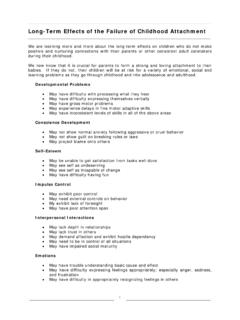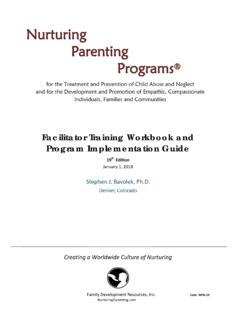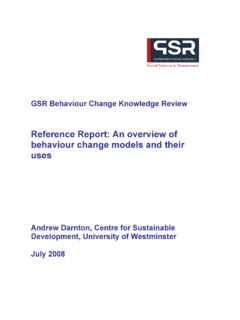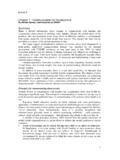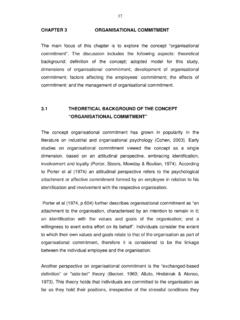Transcription of The Nurturing Parenting Programs
1 The Nurturing Parenting Programs and the Six Protective Factors The Effectiveness of theory , Research and Practice for the Prevention and Treatment of Child Abuse and Neglect Stephen J. Bavolek, Principle Author of the Nurturing Parenting Programs and the Adult- Adolescent Parenting Inventory (AAPI-2). Michelle S. Rogers, LCSW/CFLE, Nationally Recognized Trainer and Consultant in the Nurturing Parenting Programs Protective Factors: History and Development In 1995, the initial phase of an ongoing retrospective study began in San Diego to examine the link between childhood stressors and adult health.
2 From 1995 to 1997, nearly 17,500 adults were asked to complete a questionnaire about their childhood. Ten exposures of experiences were studied: physical, emotional and sexual abuse; physical and emotional neglect;. household substance abuse, mental illness or incarceration; mother treated violently;. separation/divorce. The results of the study indicated that more than half of the respondents reported at least one exposure and 25% reported two or more childhood exposures. Persons who experienced four or more childhood exposures, compared to those who had none, had a 4 to 12.
3 Fold increased health risk for alcoholism, drug abuse, depression, attempted suicide, smoking, poor self-rated health, sexually transmitted diseases, physical inactivity and severe obesity. The data specifically related to child abuse and neglect pointed out that 28% of the adults indicated they were physically abused; 21% sexually abused; 15% emotionally neglected; 11%. emotionally abused; and 10% physically neglected. The research became known as the Adverse Childhood Experiences study (ACE). The data generated from the ACE study clearly linked the effects of a childhood abuse and neglect with health problems later in life ( ).
4 Influenced by the data generated from the ACE study, in 2003 the Center for the Study of Social Policy (CSSP) developed a logic model for reducing child abuse and neglect based on building resiliency as a way of reducing risk factors. In reviewing the literature, Horton (2003). found several conditions that appeared to be related to the lower incidence of child abuse and neglect. These conditions are known as protective factors . The protective factors identified by CSSP include: 1) Parental resilience; 2) Social connections; 3) Knowledge of Parenting and child -1- development; 4) Concrete support in time of need; and 5) Social and emotional competence of children.
5 Recently, the Family Resource Information, Education, and Network Development Services (FRIENDS) located in North Carolina, established the National Resource Center for Community-Based Child Abuse Prevention (CBCAP). The CBCAP, a service of the US. Department of Health and Human Services (DHHS), Administration for Children and Families (ACF), Children's Bureau, recently identified a sixth protective factor: Nurturing and early attachment. According to CBCAP, protective factors are conditions in families and communities that, when present, increase the health and well-being of children and families.
6 CBCAP states that protective factors are positive attributes that strengthen all families and that families themselves often want to build upon. Focusing on promoting protective factors rather than an approach that focuses on reducing risk factors may encourage parents to feel more comfortable seeking out extra support, help service providers develop positive relationships with families, and help families build and draw on natural support networks within their family and community (CBCAP, 2012). Nurturing Parenting Programs The ACE study of 1995 provided an in-depth look of the long lasting consequences of child abuse and neglect.
7 The Nurturing Parenting Programs developed in 1983, twelve years prior to the initiation of the ACE study, were designed specifically to help families who have come to the attention of Social Services for child abuse and neglect. Nurturing Parenting Programs have a 30 year rich history of solid research in the treatment and prevention of child abuse and neglect with the initial study funded by the National Institute of Mental Health (Bavolek, McLaughlin & Comstock, 1983). A review of the Nurturing Programs shows the lessons incorporate the theoretical and practical foundation of all six of the currently recognized protective factors.
8 Nurturing Parenting Programs continue to reinforce and confirm 30 years of ongoing, strength based, family centered, evidenced based work. Nurturing Parenting Programs have also received recognitions and accreditations from: The Annie Casey Foundation; the California Evidence-Based Clearinghouse for Child Welfare (CEBC); the Office of Juvenile Justice and Delinquency Prevention (OJJDP), and the National Registry of Evidenced Programs and Practices (NREPP). -2- Twenty-five varied Nurturing Parenting Programs and Nurturing Curricula are available.
9 Each is grounded in the same Nurturing philosophy, principles, protective factors, and constructs. Each program is population specific, family centered, with flexible programming designed to meet the specific cultural and developmental capabilities of individuals and families. The reader is referred to for a review of all the Programs . Since 1983, twenty- seven (27) studies have been published or available as final reports that support the effectiveness of the Nurturing Programs as proven approaches to the prevention, intervention and treatment of child abuse and neglect.
10 Consistent findings include: High rate of parental completion of program classes;. Significant increases in post assessments of parental knowledge of Nurturing practices;. Maintenance of new skills over time;. Lower than national rates of recidivism among families completing their program;. and Positive cost benefit ratio nearing neutrality as a result of the low rates of recidivism. To review all the studies in their entirety, log on to and click on Validation Studies. Approximately million families in all 50 states and 12 countries world-wide have participated in Nurturing Program classes available in English, Spanish, Creole, Arabic, Chinese and Hmong.

